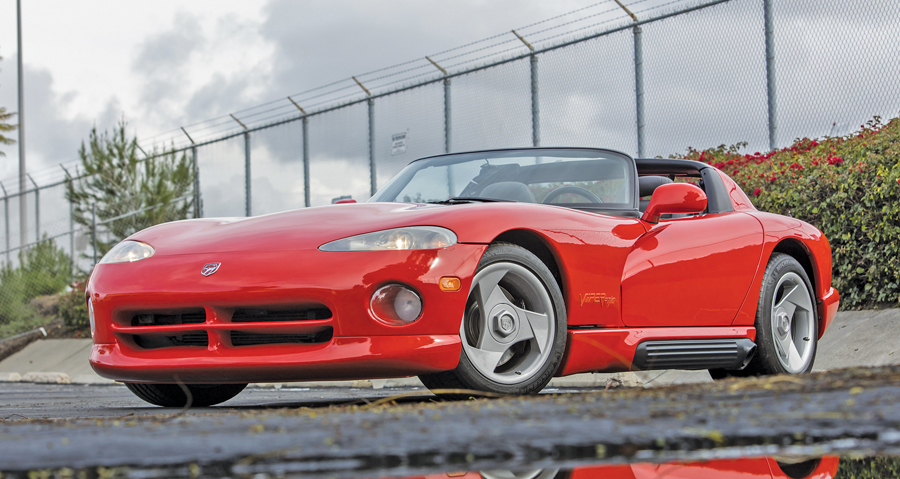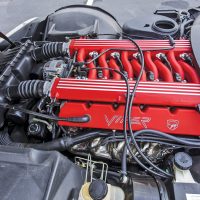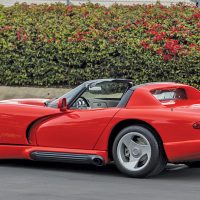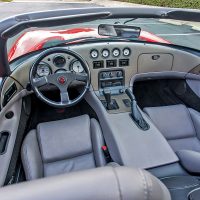SCM Analysis
Detailing
| Vehicle: | 1992 Dodge Viper RT/10 Roadster |
| Years Produced: | 1992–2010, 2013–17 |
| Number Produced: | 31,500 |
| Original List Price: | $2,000 |
| SCM Valuation: | $40,000 (aggregate) |
| Tune Up Cost: | $500 |
| Chassis Number Location: | On left A-pillar |
| Engine Number Location: | On rear of block, below right cylinder head |
| Club Info: | Viper Club of America |
| Website: | http://www.viperclub.org |
| Alternatives: | 1992–2010 Chevrolet Corvette, 2020 Shelby GT500, 1996–2014 Jaguar XKR |
| Investment Grade: | B |
This car, Lot 65, sold for $285,500, including buyer’s premium, at Bonhams’ auction in Scottsdale, AZ, on January 16, 2020.
The talk of Scottsdale this year was Rick Hendrick’s purchase of the first C8 Corvette for $3 million at the Barrett-Jackson auction. However, across town at Bonhams, a car no less significant commanded less than 10% of that money.
The first Dodge Viper off the line, Lee Iacocca’s personal car, sold for $285,500.
Maybe it’s unfair to compare those sales side by side. The new hotness is always more exciting than a well-kept museum piece, and Mr. Hendrick has a history of spending a lot of money on charity auction cars.
He bought the first C7 Corvette, the first C7 Z06, and the first C7 ZR-1. Oh, and the first Camaro ZL1 too. So there’s a pattern here.
Yet a trip through SCM’s Platinum Auction Database shows us this: When comparing Vipers to Vipers, what stands out about this sale is that it doesn’t really stand out.
The very last production Viper, a 2017 coupe (SCM# 6875671), sold for $500,000 in June 2018, setting the high-water mark for the breed.
More recently, a one-of-one 2017 ACR sold for $286,000 in April 2019 (SCM# 6901878) and a one-of-25 2017 Viper GTC ACR Snakeskin Edition sold for $220,000 (SCM# 6901879) on the same day.
All of these examples featured low miles and something special about the car, but those qualities are not exactly rare for Vipers.
Revolutionary in its day
The Viper was a bold move for Iacocca’s Dodge back in 1992. The car was eye-poppingly powerful, with 400 horsepower from a Lamborghini-tuned V10 engine. The first-generation Viper hit 60 mph in 4.2 seconds, and you would see the quarter-mile mark in 12.6 seconds. The Viper could corner at an honest one-gee in stock trim.
On top of that, the Viper had the audacity to be raw and uncomfortable. You could seriously burn your leg on the side exhausts if you weren’t careful getting out of the car. Car and Driver magazine famously cooked bacon and eggs on the doorsill of a Viper. The convertible top was barely an afterthought, and the windows went on with zippers.
The saving grace for that top was that few people were foolhardy enough to drive an early Viper in the rain. The first-gen model was a beast, and the driver had to learn how to control it — or face the consequences. The Viper didn’t even have rudimentary anti-lock brakes or the traction/stability control that debuted on the 1992 Corvette. There were no air bags if you crashed, and no air conditioning to defog the windshield.
Subsequent generations added more creature comforts and safety features until the Viper was quite tractable and cozy in either its coupe or convertible form. When the Viper ended its first production run in 2010, horsepower was up to 600 and the Viper was setting lap records at the Nürburgring — and across America.
Dodge brought the Viper back in 2013. The car then boasted 640 horsepower and a full set of electronic driver-assistance and safety features. The 0–60 mph time was down to 3.5 seconds. That generation ran to the end of the 2017 model year. Then Dodge retired the Viper for good — and closed the Conner Assembly Plant where the car was made.
Buying a Viper
The consensus around the Sports Car Market water cooler is to buy early Vipers. These cars deliver a lot of bang for your buck. Looking through the SCM Platinum Auction Database, about half of the Vipers that cross the block sell for under $50,000, with most falling in the $30,000–$50,000 range. Those under $30,000 are usually first-generation cars from 1993 to 1995.
Dodge built at least 31,500 Vipers over the car’s quarter-century of production. The list of special editions and limited packages is dizzying.
The Vipers that turn up at auction tend to be the extreme low-miles and one-of-few specials, but that doesn’t always guarantee a high price. For example, the serial-number 2 pilot production vehicle of the second-generation Viper, a 1996 roadster with just 11,100 miles (SCM# 6901880), sold at Barrett-Jackson Palm Beach on April 12, 2019, for $26,400.
That kind of story repeats over and over. Just 13 lots after Iacocca’s Viper at Bonhams, the first-ever 1993 Hennessey Venom 600 with 6,691 miles on the clock sold for $40,320. Hennessey built this one to 600 horsepower, and a subsequent owner added a blower and claims 1,000 horses. All that aftermarket gear doubtless kept the price down, but if what you wanted was a special low-miles Viper, this one was downright affordable.
Over at Barrett-Jackson Scottsdale, 22 Vipers came up for sale this year. Sale prices ranged from $31,900 to $242,000. Six of those Vipers were some kind of VIN #1 model, and five were limited editions. Fifteen cars had fewer than 10,000 miles on the clock. Of those, the least-used had four miles showing, plus one seven-mile and one 10-mile car. Three more showed less than 1,000 miles. Predictably, the overlap between special editions, ultra-low miles, and high prices was substantial.
Here’s the bottom line: If you have $50,000, you can choose from a variety of first-generation Vipers with low miles. The VIN 1 and special editions that haven’t been driven may sell for a quarter-million dollars, give or take a few thousand, but the run from the factory is quite affordable and likely to remain so.
Dodge built a lot of Vipers. Oh yeah you should buy one — they’re a lot of fun. ♦






